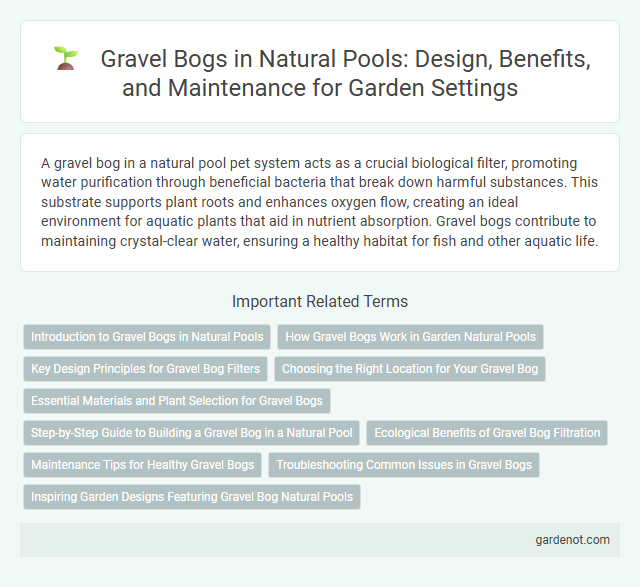A gravel bog in a natural pool pet system acts as a crucial biological filter, promoting water purification through beneficial bacteria that break down harmful substances. This substrate supports plant roots and enhances oxygen flow, creating an ideal environment for aquatic plants that aid in nutrient absorption. Gravel bogs contribute to maintaining crystal-clear water, ensuring a healthy habitat for fish and other aquatic life.
Introduction to Gravel Bogs in Natural Pools
Gravel bogs in natural pools function as essential filtration systems, utilizing layers of gravel and diverse aquatic plants to naturally purify water by trapping sediments and absorbing nutrients. This biological filtration process enhances water clarity and supports a balanced ecosystem by promoting beneficial microbial activity. Gravel bogs also contribute to the aesthetic appeal of natural pools by integrating seamlessly with the surrounding landscape.
How Gravel Bogs Work in Garden Natural Pools
Gravel bogs in garden natural pools function by utilizing layers of gravel and sand that promote biological filtration and water purification. The porous gravel provides a habitat for beneficial bacteria and aquatic plants, which absorb nutrients and break down organic matter, maintaining crystal-clear water. This natural filtration system supports a balanced ecosystem while enhancing water circulation and oxygen levels in the pool.
Key Design Principles for Gravel Bog Filters
Gravel bog filters rely on layered gravel and sand substrates that facilitate natural biofiltration by promoting beneficial microbial growth and nutrient absorption. Key design principles include ensuring adequate water flow rates, maintaining optimal substrate depth between 30-50 cm for effective filtration, and incorporating diverse gravel sizes to enhance surface area for microbial colonization. Proper placement of aquatic plants with complex root systems further stabilizes substrates and improves water purification efficiency in natural pool systems.
Choosing the Right Location for Your Gravel Bog
Selecting the optimal location for a gravel bog involves assessing soil drainage, sunlight exposure, and proximity to natural water sources to ensure healthy plant growth and water filtration. Ideal sites have well-draining soil with partial to full sun, promoting oxygen flow through the gravel substrate and supporting aquatic vegetation. Avoid low-lying areas prone to stagnation or flooding to maintain water clarity and ecosystem balance in your natural pool system.
Essential Materials and Plant Selection for Gravel Bogs
Gravel bogs require essential materials such as coarse gravel, sand, and an underlying layer of permeable substrate to ensure optimal water filtration and aeration. Selecting plants like sedges, rushes, and moisture-loving grasses that thrive in semi-aquatic conditions enhances the natural purification process and supports biodiversity. Incorporating native species adapted to wet environments promotes ecological balance and reduces maintenance efforts in gravel bog systems.
Step-by-Step Guide to Building a Gravel Bog in a Natural Pool
Creating a gravel bog in a natural pool involves excavating a shallow basin, typically 12-18 inches deep, and filling it with layers of washed gravel and sand to promote beneficial bacteria growth and natural filtration. Plant moisture-loving species such as cattails and reeds in the gravel to enhance the biological filtration process, improving water clarity and quality. Regular maintenance includes monitoring plant health and occasional gravel rinsing to prevent clogging, ensuring optimal eco-friendly water purification.
Ecological Benefits of Gravel Bog Filtration
Gravel bog filtration in natural pools enhances water quality by promoting the growth of beneficial microorganisms that break down organic matter and pollutants. This filtration system supports biodiversity by creating habitats for aquatic plants and invertebrates essential for a balanced ecosystem. Efficient nutrient cycling through gravel bogs reduces algae growth, maintaining clear and healthy water conditions.
Maintenance Tips for Healthy Gravel Bogs
Gravel bogs require regular monitoring to maintain optimal water levels and prevent stagnation, which supports a balanced ecosystem for aquatic plants. Remove debris and dead plant material frequently to avoid nutrient buildup that can lead to algae growth and water quality degradation. Periodic rinsing or replacement of gravel helps maintain proper filtration, ensuring the gravel bog remains a healthy habitat within natural pools.
Troubleshooting Common Issues in Gravel Bogs
Gravel bogs often face drainage problems due to compacted substrate, leading to water stagnation and root rot in aquatic plants. Regularly monitoring water flow and gently aerating clogged areas can restore proper circulation and oxygenation, preventing algae overgrowth. Addressing nutrient imbalances with natural filtration techniques, such as biofiltration gravel layers, helps maintain a healthy ecosystem in the gravel bog.
Inspiring Garden Designs Featuring Gravel Bog Natural Pools
Gravel bog natural pools create a visually stunning and eco-friendly water feature by combining the natural filtration of gravel with lush bog plants. These designs enhance garden biodiversity, support aquatic life, and require minimal maintenance while offering a serene, organic aesthetic. Incorporating native bog plants and layered gravel substrates promotes water clarity and sustainability in inspiring garden environments.
Gravel bog Infographic

 gardenot.com
gardenot.com